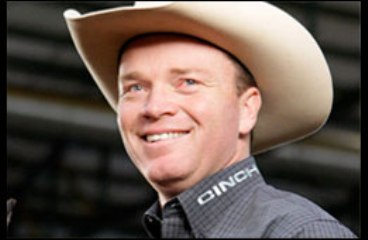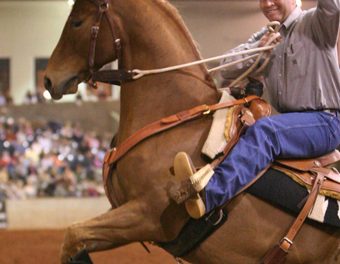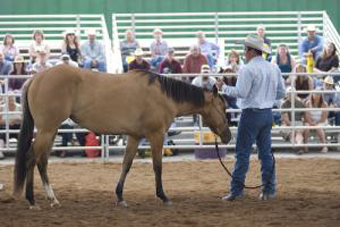 Before you worry about riding your horse one handed, you need to make sure you have excellent control two handed. Start practicing by riding with your hands in a position where it will be easy to transition to one handed riding, keeping to a small area in front of your saddle horn. If you want to ride one handed, you must first double check and reinforce your two-handed foundation. Think of breaking your horse down into compartments: head and neck, shoulders, ribcage, and hindquarters. Now, can you move each of your horse’s sections towards and away from the fence? Can you ride all these maneuvers while keeping your horse’s head and neck soft? Can you get a good stop without moving your hands out of position? All of these questions need to be answered “yes” with two hands before you should start working on riding with one hand.
Before you worry about riding your horse one handed, you need to make sure you have excellent control two handed. Start practicing by riding with your hands in a position where it will be easy to transition to one handed riding, keeping to a small area in front of your saddle horn. If you want to ride one handed, you must first double check and reinforce your two-handed foundation. Think of breaking your horse down into compartments: head and neck, shoulders, ribcage, and hindquarters. Now, can you move each of your horse’s sections towards and away from the fence? Can you ride all these maneuvers while keeping your horse’s head and neck soft? Can you get a good stop without moving your hands out of position? All of these questions need to be answered “yes” with two hands before you should start working on riding with one hand.
I like to start my one handed practice in a snaffle. While the snaffle bit is not designed for one handed riding, I still think it is important to be able to do everything you can do with a shank bit in the snaffle first. Just keep in mind that you may need to add your second hand back in at times during your training since the snaffle is really not designed to be used the way you are going to use it. Just try your best to do everything as if you only have one hand available. If you lay on a neck rein and your horse’s nose tips the opposite way you want him to go, you are putting too much direct pull on the rein. The neck rein is a pre-cue: a cue that comes before another cue. Riding one handed uses a lot of pre-cues. Over time, your horse will start responding to the pre-cue so you seldom have to give the cue itself. In this example, the pre-cue is the neck rein and the direct rein would be the cue. The indirect cue precedes the direct cue.
When you start practicing with one hand, you want to be sure your horse is not rushing forward or diving his shoulder into the turns. He should not be tipping his nose to the outside of the turn, he needs to be looking where he is going. Think in terms of riding on a clock face so you are very specific in where you ask your horse to turn. Pick a spot on the clock and turn him there using the neck rein, and if he does not respond correctly, back up your pre-cue with a direct rein cue. Think about bringing your horse under your hand smoothly without his shoulders dropping.
Before you transition to a shank bit, you should be able to complete all your exercises softly and correctly in the snaffle bit. I like a short mild shank with a three piece mouthpiece. I like my shank to be only a 2:1 increase in pressure. Remember that the shank bit not only adds pressure on the bit, but also on the poll and across the brow band. Because of this, you need to be very careful as a rider that you reduce the amount of pressure you are using on the reins when you start riding in a shank bit. The shank should be used to reduce the amount of movement you need to make with your hands when you give a cue. It makes cues less obvious and should make your communication with your horse appear smooth and minimal. Don’t move to a shank bit assuming it will create a wonderful response to cues that have not been trained solidly in the snaffle bit. The shank is not a crutch or a way to correct problems. Really the main reason to go to a shank bit when you can do everything in a snaffle is because if you plan to show, most showing associations will require you to be in a shank bit. If you have no interest in showing, you can just stay in the snaffle bit if you choose.
As you train, you will run into situations where you go back to riding with two hands for a moment or a longer period of time. This is just fine. It is much more important to keep things correct, soft, and on cue than it is to ride with one hand. Never sacrifice correct movement just so you can say you did something with one hand. Don’t be afraid to pick up on the second rein and make corrections as you go to keep your horse on track.
Enjoy your horses as you progress to more advanced levels of training together, and until next time, may God bless the trails you ride.
For more information on Ken McNabb’s programs call us at 307-645-3149 or go to www.kenmcnabb.com.




